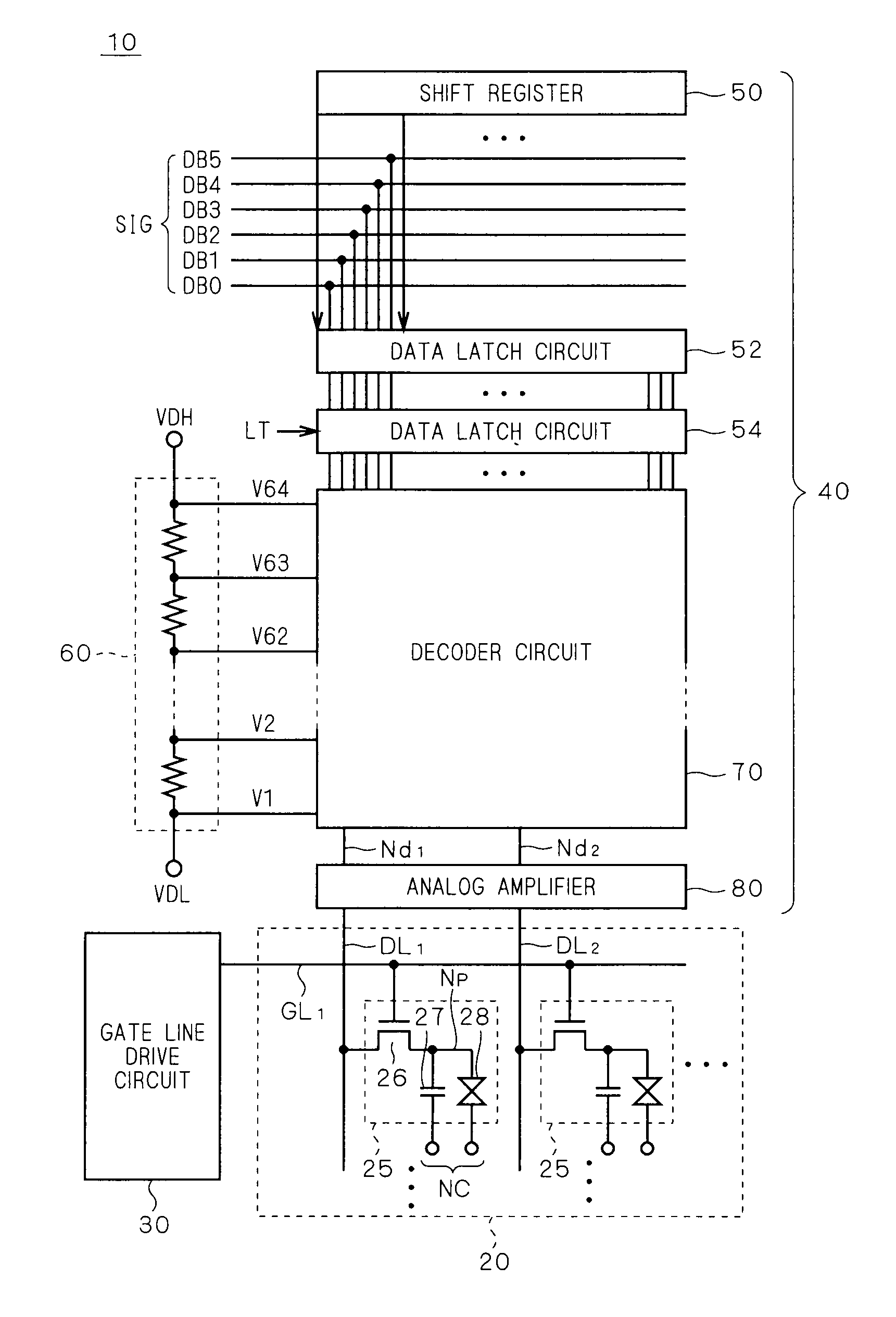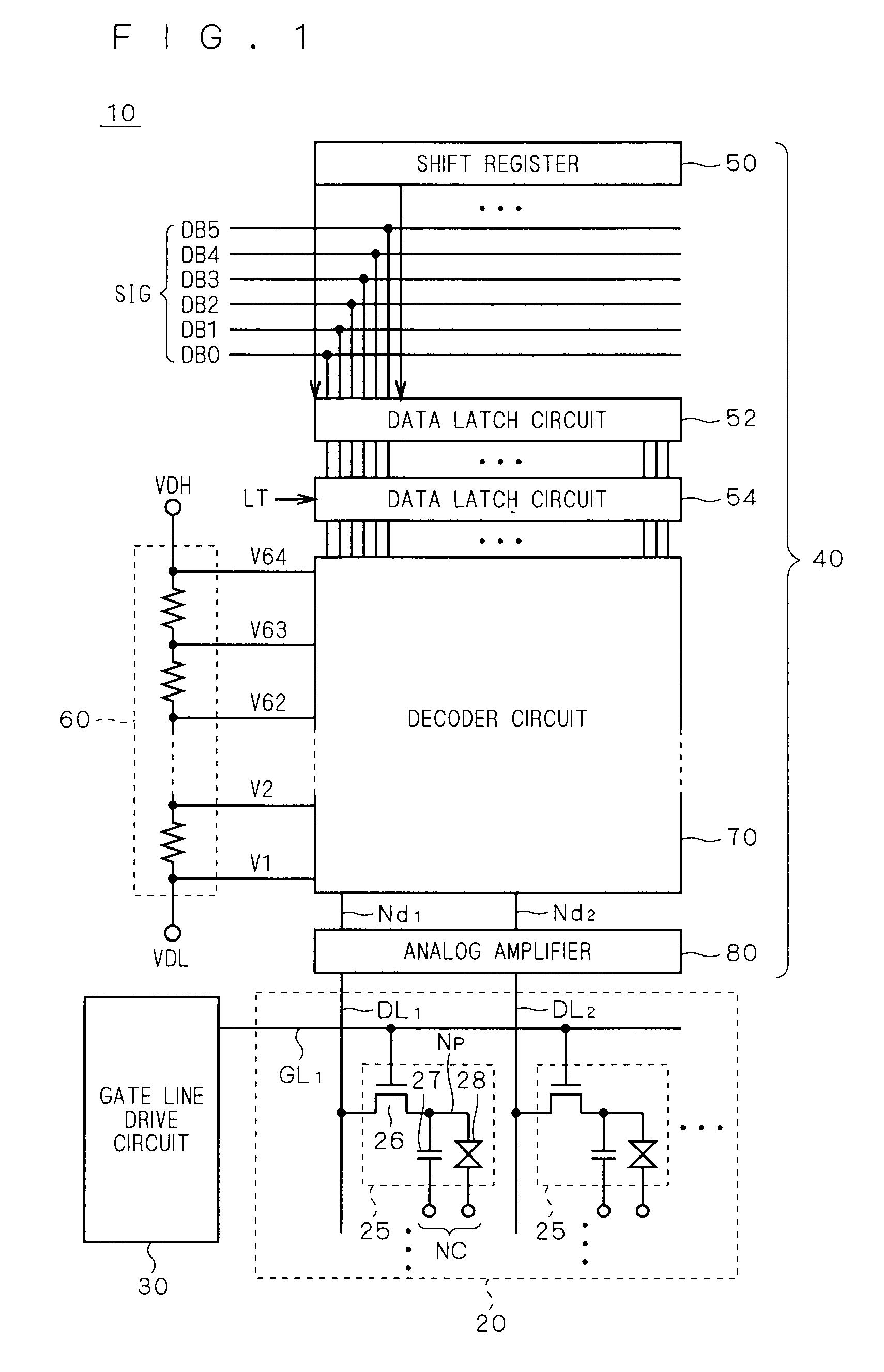Shift register circuit and image display comprising the same
a technology of shift register and image display, which is applied in the direction of logic circuits, digital storage, instruments, etc., can solve the problems of reducing the rising and falling speed of output signals, affecting the operation of unit shift registers, and affecting the implementation of high-speed operations. , to achieve the effect of preventing the reduction of drive capability and preventing the reduction of defective operations
- Summary
- Abstract
- Description
- Claims
- Application Information
AI Technical Summary
Benefits of technology
Problems solved by technology
Method used
Image
Examples
embodiment 1
[0058]FIG. 1 is a schematic block diagram showing the constitution of a display according to the present invention and showing the whole constitution of a liquid crystal display 10 as a representative example of the display.
[0059]The liquid crystal display 10 comprises a liquid crystal array 20, a gate line drive circuit (scan line drive circuit) 30 and a source driver 40. Although it will be clear from the following description, a shift register according to this embodiment of the present invention is mounted on the gate line drive circuit 30.
[0060]The liquid crystal array 20 comprises a plurality of pixels 25 arranged like a matrix. Gate lines GL1, GL2, . . . (collectively called the “gate line GL”) are connected to rows of pixels (referred to as the “pixel lines” also hereinafter), respectively and data lines DL1, DL2, . . . (collectively called the “data line DL”) are connected to the columns of pixels (referred to as the “pixel columns” also hereinafter), respectively. In FIG. ...
embodiment 3
[0140]FIG. 13 is a circuit diagram showing the constitution of the unit shift register according to the As shown in FIG. 13, the source of a transistor Q2 is connected to a first clock terminal CK1. That is, the main electrode (drain) of the transistor Q2 is connected to an output terminal OUT and a clock signal CLK having a phase different from that of a clock signal / CKL to be inputted to a control electrode (gate) is supplied to another main electrode (source).
[0141]According to this constitution, when the clock signal / CLK inputted to the gate of the transistor Q2 becomes L level and the transistor Q2 is turned off, since the clock signal CLK inputted to the source becomes H level, a state equivalent to a case where the gate of the transistor Q2 is negatively biased with respect to the source is provided. Thus, since a threshold voltage that shifted in the positive direction returns in the negative direction and makes a recovery, there is an effect that the drive capability of ...
embodiment 5
[0169]FIG. 17 is a circuit diagram showing the unit shift register according to the According to the unit shift register SR shown in FIG. 17, the gate of a transistor Q5 and a first clock terminal CK1 are not directly connected and a level adjustment circuit 100 is interposed therebetween. The level adjustment circuit 100 lowers the H level of a clock signal inputted to the first clock terminal CK1 by a predetermined value (reduces the absolute value of the H level based on L level) and then supplies it to the gate of the transistor Q5. That is, the level adjustment circuit 100 functions to reduce the amplitude of the clock signal inputted to the first clock terminal CK1 by the predetermined value.
[0170]The level adjustment circuit 100 in the example shown in FIG. 17 comprises transistors Q9 and Q10. When it is assumed that the node connected to the gate of the transistor Q5 is defined as node N3, the transistor Q9 (third transistor) is connected between the node N3 and the first c...
PUM
 Login to View More
Login to View More Abstract
Description
Claims
Application Information
 Login to View More
Login to View More - R&D
- Intellectual Property
- Life Sciences
- Materials
- Tech Scout
- Unparalleled Data Quality
- Higher Quality Content
- 60% Fewer Hallucinations
Browse by: Latest US Patents, China's latest patents, Technical Efficacy Thesaurus, Application Domain, Technology Topic, Popular Technical Reports.
© 2025 PatSnap. All rights reserved.Legal|Privacy policy|Modern Slavery Act Transparency Statement|Sitemap|About US| Contact US: help@patsnap.com



